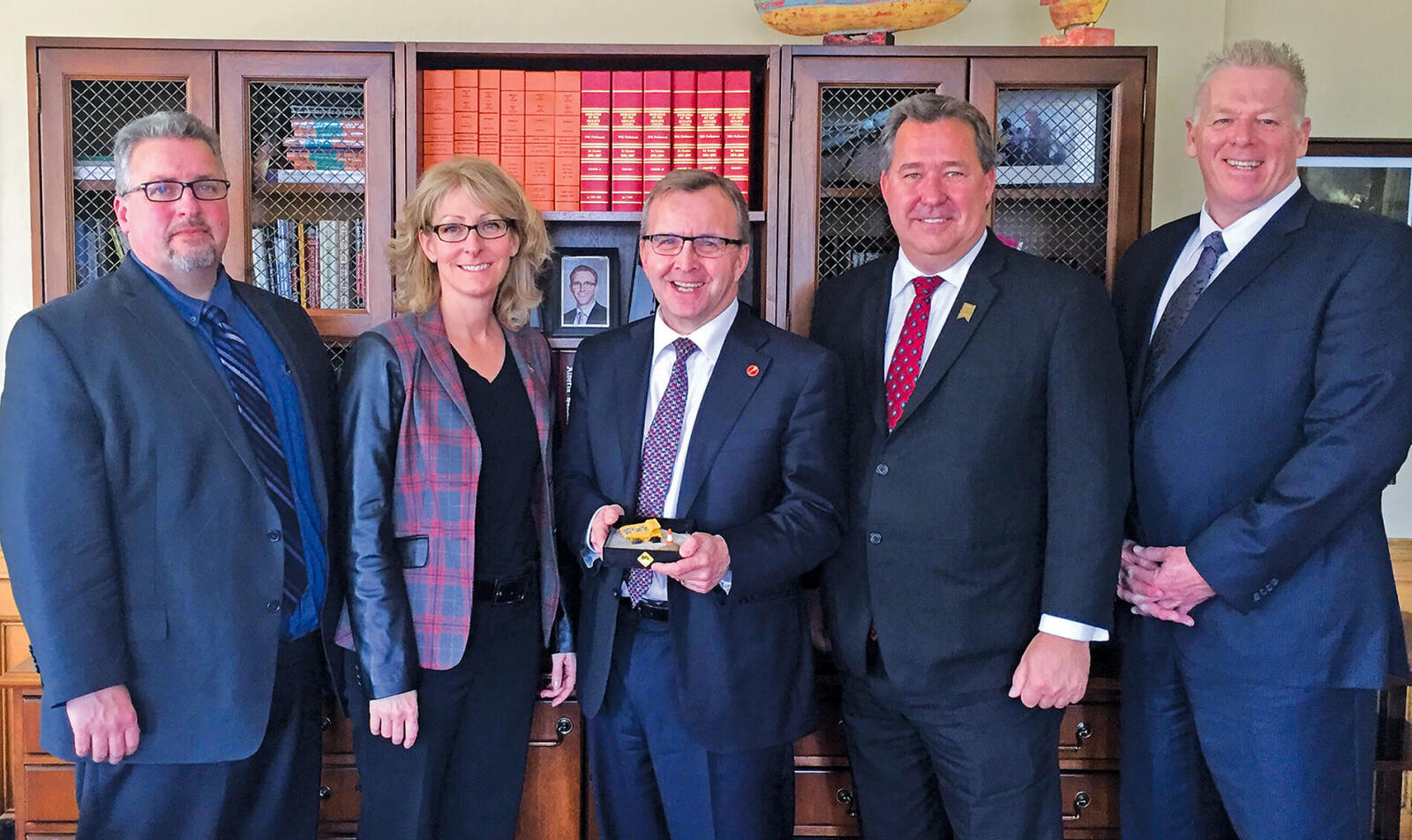June 15, 2016

Senator Grant Mitchell (centre) accepting a DigSafe “MiniDig” after hosting the CCGA in the Senate during DigSafe month in April. (l-r) are Mike Sullivan, President, CCGA; Nathalie Moreau, Chair, Quebec CGA; Darwin Durnie (CPWA) and Ian Munro (ORCGA).
Utility hits and locate requests increase in 2015
By Terry Murphy CLM
 The statistical data for 2015 indicates that utility hits in Ontario were up 14.8 per cent over 2014 — with utility hits (damages) increasing from 3,843 to 4,434. The main reason is there were large increases in the number of utility locate requests (in other words, more industry digging as well). This increase in locate requests was partly because many new industry firms have to report their data under Bill 8, the Ontario Underground Infrastructure Notification System Act, 2012, which requires all firms owning underground utilities to be on the One Call System and to report damages. This is very positive news for the damage prevention industry in Ontario.
The statistical data for 2015 indicates that utility hits in Ontario were up 14.8 per cent over 2014 — with utility hits (damages) increasing from 3,843 to 4,434. The main reason is there were large increases in the number of utility locate requests (in other words, more industry digging as well). This increase in locate requests was partly because many new industry firms have to report their data under Bill 8, the Ontario Underground Infrastructure Notification System Act, 2012, which requires all firms owning underground utilities to be on the One Call System and to report damages. This is very positive news for the damage prevention industry in Ontario.
The key categories are landscaping and fencing. Both show sizable increases in the number of utility hits for 2015 compared to 2014. Again, this has to be balanced by the increased number of locate requests that were called into ON1CALL. When you look at the key statistical measurement that we track closely on DIRT, the hits per 1,000 locate requests, it has remained about the same, year over year.
Another alarming fact is the other main root cause of utility hits. Each year, damages resulting from insufficient or poor excavation practices account for 33 per cent of utility hits. Almost one-third of utility hits happen because the contractor is not doing his excavation properly nor safely enough. These two reasons make up 72 per cent of all reported damages. We can easily reduce the number of damages by further educating our landscape and fencing industries on these two main root causes. The important consideration here is that these stats are the same each year — they haven’t changed in years.
Terry Murphy can be reached at tvmurphy@ca.inter.net.
 The statistical data for 2015 indicates that utility hits in Ontario were up 14.8 per cent over 2014 — with utility hits (damages) increasing from 3,843 to 4,434. The main reason is there were large increases in the number of utility locate requests (in other words, more industry digging as well). This increase in locate requests was partly because many new industry firms have to report their data under Bill 8, the Ontario Underground Infrastructure Notification System Act, 2012, which requires all firms owning underground utilities to be on the One Call System and to report damages. This is very positive news for the damage prevention industry in Ontario.
The statistical data for 2015 indicates that utility hits in Ontario were up 14.8 per cent over 2014 — with utility hits (damages) increasing from 3,843 to 4,434. The main reason is there were large increases in the number of utility locate requests (in other words, more industry digging as well). This increase in locate requests was partly because many new industry firms have to report their data under Bill 8, the Ontario Underground Infrastructure Notification System Act, 2012, which requires all firms owning underground utilities to be on the One Call System and to report damages. This is very positive news for the damage prevention industry in Ontario.Notifications are up sharply
When a request for a locate is submitted by an excavating contractor to ON1CALL, each utility having infrastructure at that particular address must provide markings on the ground. This request to the utility is called a notification. In 2015, there were an average of 6.8 notifications for every single locate request. In Ontario, the number of notifications increased from 5,603,000 to 6,534,000. This means the number of locate requests increased proportionately. This gives you an indication of the increased digging activity for the year.Green industry utility hits
There are five key categories in the Green Industry Group as tracked by the industry Damage Information Reporting Tool (DIRT). They are represented below with the number of hits in each category for a three year period.The key categories are landscaping and fencing. Both show sizable increases in the number of utility hits for 2015 compared to 2014. Again, this has to be balanced by the increased number of locate requests that were called into ON1CALL. When you look at the key statistical measurement that we track closely on DIRT, the hits per 1,000 locate requests, it has remained about the same, year over year.
| GREEN INDUSTRY GROUP | 2013 | 2014 | 2015 | PER CENT OF CHANGE 2014 TO 2015 |
| Landscaping | 334 | 258 | 310 | +20.1% |
| Fencing | 424 | 257 | 347 | +35.0% |
| Irrigation | 1 | 2 | 10 | +500.0% |
| Waterways | 29 | 34 | 1 | -0.03% |
| Agriculture | 3 | 4 | 1 | -77.0% |
Root causes of utility hits
An alarming fact is that 39 per cent of all utility hits happen because the contractor did not call ON1CALL for locates. Can you imagine that in two of every five jobs, the contractor did not even call for locates? Considering the service is free, and the fact that you may kill someone if you hit a high pressure gas line, 39 per cent of contractors couldn’t be bothered to pick up the phone and dial a free number to get locates done.Another alarming fact is the other main root cause of utility hits. Each year, damages resulting from insufficient or poor excavation practices account for 33 per cent of utility hits. Almost one-third of utility hits happen because the contractor is not doing his excavation properly nor safely enough. These two reasons make up 72 per cent of all reported damages. We can easily reduce the number of damages by further educating our landscape and fencing industries on these two main root causes. The important consideration here is that these stats are the same each year — they haven’t changed in years.
Senate recognition
During April’s Dig Safe Month in Ottawa, the Senate of the Federal Government recognized the Canadian Common Ground Alliance and their provincial counterparts with a reading in the Senate Chamber. Senator Grant Mitchell praised the CCGA for their damage prevention work across Canada. The Senator was presented with a mini-excavator desk model for his office (see photo). Attending the ceremony for the industry was Mike Sullivan, President of the Canadian Common Ground Alliance and Ian Munro, President of the Ontario Regional Common Ground Alliance.ORCGA membership is available
If you would like membership information on the ORCGA or the damage prevention industry in Ontario, please contact Jennifer Parent at the ORCGA office. She can be contacted at 1-866-446-4493 or 905-532-9836 or at Jennifer@orcga.com.Terry Murphy can be reached at tvmurphy@ca.inter.net.